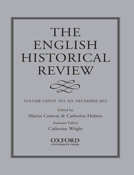-
Views
-
Cite
Cite
Jeremy Catto, Heresy and Heretics in the Thirteenth Century: The Textual Representations, by L.J. Sackville, The English Historical Review, Volume 127, Issue 529, December 2012, Pages 1486–1487, https://doi.org/10.1093/ehr/ces255
Close - Share Icon Share
Extract
This is a book about the idea of heresy conveyed in a series of texts written to refute the beliefs of thirteenth-century Cathars and Waldensians, or to aid proceedings against them. As the direct evidence, in the form of literary remains, of either group is sparse, these texts provide the bulk of information on the subject and their interpretation is therefore the focal point of historical enquiry. Lucy Sackville has worked with Peter Biller on the topic, and is therefore in the critical tradition which goes back through Herbert Grundmann and Arno Borst to the nineteenth-century editors of the texts. The idea that they cannot be taken literally is not new; Sackville rather implausibly attributes the focus on the nature and production of the texts to the importation of literary and cultural theory, though it merely reaffirms sound critical principles well understood since the eighteenth century. What she has done is to describe and categorise a large number of texts, some of them unpublished, in a systematic way, and to interpret them in the light of their particular genre. First, largely from Italy in the 1230s, came polemical tracts against heretics; they were the product of an era of more or less open debate, before the legal apparatus of inquisition had been perfected; the authors assumed a degree of learning among their opponents, addressing, as Sackville acutely puts it, ‘the content of the heresy, not the condition of the heretic’ (p. 39). By the mid-century, with the Dominican order in the lead, the popular sermon underpinned by systematic theology had become the most powerful dissuader of potential heretics. In aid of the sermon a new genre of ‘texts for edification’ had emerged, backed up by manuals for preachers (the most notable by Stephen of Bourbon, OP), collections of exempla and lives of prominent friars. The individual laymen and women who might be persuaded by heretics were now the targets of sermons, in which the theme of the false piety and deceptive mortifications of the heretic missionaries was prominent. Behind the persuaders was the law. The canonists of the mid-century were thoroughly professional, with a systematic training; they were ready to develop a careful procedure for dealing with heretics, armed with decrees ancient and modern and, most usefully, from the Fourth Lateran Council. They progressively created the standard procedure of inquisition, generating another class of texts: decrees, consilia or legal opinions, collections of depositions and sentences. Their restricted and formalised nature, geared to the practicalities of judgment, offers historians the least useful perspective, perhaps, on the contemporary heretic. On the other hand, the manuals for inquisitors, from the pens of Raniero Sacconi (a former Cathar), Anselm of Alessandria and numerous anonymous inquisitors—interrelated texts which mark the way they learned from their predecessors—are among the most interesting of all: the manuals incorporate the distilled experience of inquisitors, skilled in eliciting from their subjects’ equivocations the carefully hidden signs of heretical belief and allegiance. Standing back from the exigencies of particular cases, they can reflect on the enduring character of the heresies and heretics they have encountered.



